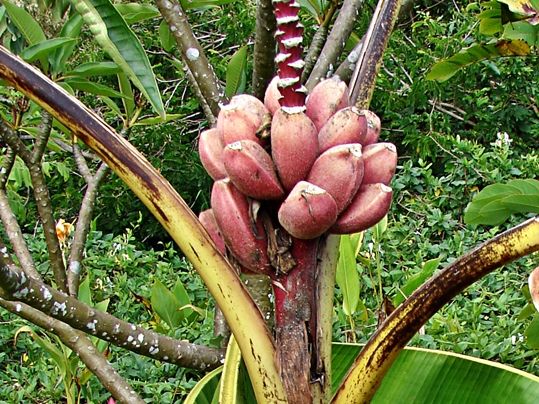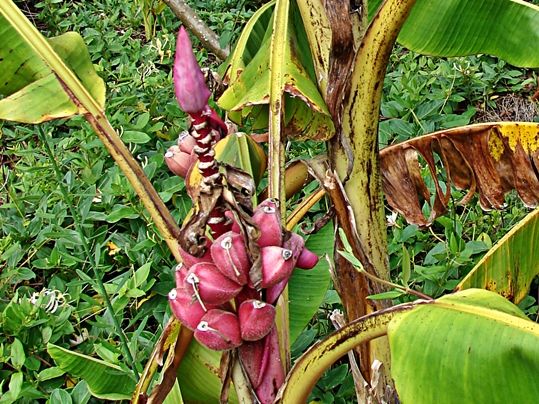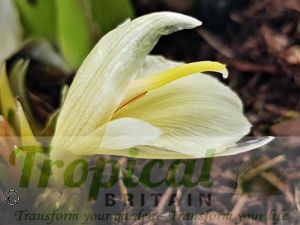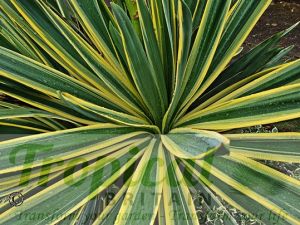Musa velutina, Velvet Pink Banana, is a compact-sized banana from the Eastern Himalayas where it grows in the Indian states of Arunachal Pradesh and Assam and Northern Myanmar. It is a fast-growing suckering banana with green foliage and a large highly-ornamental inflorescence with small golden yellow male flowers that contrast vividly against the pink bracts. The fruits that develop are chubby and pink and covered in soft velvety hairs. The only other known species of hairy-fruited banana is Musa hirta from Borneo. The fruits are also one of only five known species of banana that are schizocarpic, splitting open at maturity. They are edible and sweet although they have many black seeds
Best grown in a wind-free aspect in sun or partial shade and watered and fed liberally throughout the growing season.
Musa velutina was first described by Hermann Wendland and George Drude in 1875 from a plant that flowered at Herrenhausen Botanic Garden in Hanover, from seeds collected by Gustav Mann from Upper Assam. However, the same species had previously been described in 1867 from a now lost herbarium specimen in Calcutta by the German botanist Wilhelm Sulpiz Kurz - the curator of the herbarium at the Calcutta Botanic Gardens - as Musa dasycarpa with a brief reference to hairy fruits, the defining characteristic of the species, although a herbarium sheet at Kew of 1850 also predates this. Kurz intended to question the validity of Wendland and Drude's description in a revision of the Musaceae that he was preparing to publish but he died in 1878 before he could publish any clarification. Confusion followed when, in 1893, the Kew botanist, John Gilbert Baker reduced Musa dasycarpa to a synonym of Musa velutina when under the Vienna Code the older name had priority. However, in 2009, since Musa dasycarpa had rarely been used, Henry Väre and Markku Häkkinen, proposed to conserve Musa velutina against Musa dasycarpa under Article 14 of the International Code of Botanical Nomenclature to avoid further confusion.
A subspecies, Musa velutina subsp. markkuana - in honour of Maarku Häkkinen - with glabrous non-schizocarpic fruits and endemic to Arunchal Pradesh with populations found in the Balukpong area, West Kameng District and around Tezu and Hayulyang, was described in 2013 by Mamiyil Sabu, Alfred Joe and Puravannoor E. Sreejith.
Musa velutina is cold-tolerant and in warmer parts of the country will survive outdoors as a root-hardy herbaceous perennial providing it is situated in a warm microclimate in a sensible protected aspect - ideally under an overhanging evergreen canopy - and given a thick winter mulch. Its pseudostem should also be insulated with fleece or straw to preserve as much height as possible from year to year. A relatively small-growing banana, it can also be grown in a large container and brought in under cover during the winter months and allowed to die back into dormancy until the spring.
Probably the most ornamental of all the cold-tolerant bananas.
Additional Information
| Order | Zingiberales |
|---|---|
| Family | Musaceae |
| Synonyms | Musa dasycarpa |
| Geographical Origin | Himalayan foothills of Northeast India including Assam and Arunachal Pradesh; Northern Myanmar |
| Cultivation | Sheltered aspect in sun or partial shade. Water and feed well in the growing season. Mulch heavily in winter and fleece or otherwise insulate the pseudostem. Or bring in for winter |
| Eventual Height | 2-4 m |
| Eventual Spread | 2-3 m |
| Hardiness | Herbaceous perennial. Cold tolerant and root-hardy in warmer locations of the UK if given adequate mulch and protection |

Free DELIVERY
ON ALL ORDERS OVER £99THIS OFFER IS VALID ON ALL OUR STORE ITEMS.











